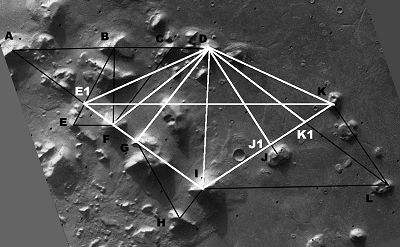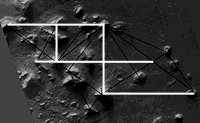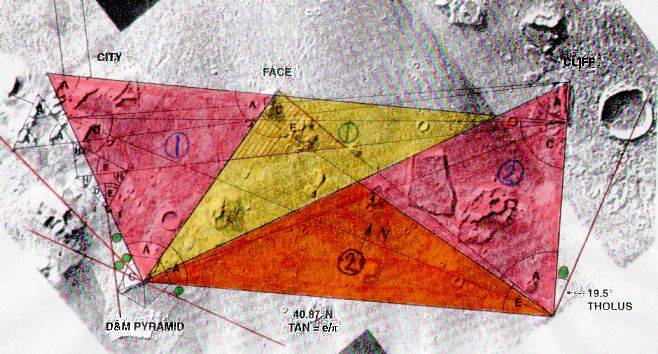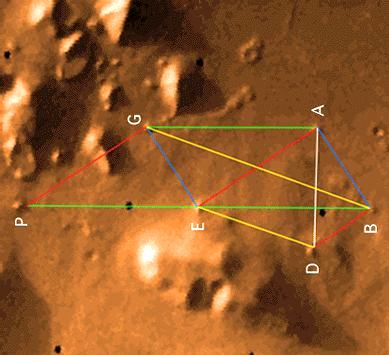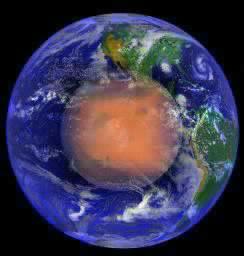 Cydonia Quest C Geometry C C c Symmetry in the Cydonia General Geometrical Model Introduction. In 1998 I came across some interesting speculations on Martin Keitel's Face on Mars website. Keitel's work suggested that Cydonian features such as the Face, D&M Pyramid and City had been so placed as to create symmetrical alignments with the more natural looking surrounding features. One of which - "J" - the MGS has shown to have the eyebrow raising "Half Face" on it, µµµ. I also think that Keitel's four sided pyramid "F" is a possible arcology. So perhaps some of these surrounding hills are not quite as "natural" as they appear.
|
The illustrations below have come from the relevant article on Martin Keitel's website. This article is well worth reading and can be accessed by clicking on the following "stargate", µµµ. c
c c c c
Looking at the Hoagland & Torun General Geometrical Model From a New Angle There are problems in testing the validity of the Hoagland & Torun Cydonia General Geometrical Model when it is applied to the larger artificial looking features at Cydonia, (µµµ). As can be seen in the illustration below, the anchoring points for the lines in the General Model involve very different types of feature. To take examples; is the peak of the D&M Pyramid the same thing as the ends of the "Cliff" or the groove across the top of the "Face"? How do we decide that the choice of these particular anchoring points are valid? These issues provide ammunition to the Enterprise Mission's critics that the anchoring points were chosen to match the tetrahedral angles that Erol Torun believed he had found in the geometry of the D&M Pyramid, (click "stargate" µµµ). (Of course these problems don't apply to the "Bright Mounds" configuration where it is very obvious that the peak of each "Bright Mound" is the valid anchoring point. As a result of this the "Bright Mounds" configuration can be statistically tested with the nearest Cray Super-computer. This has produced odds against the "Bright Mounds" configuration occurring by chance so high that it is evidence of artificiality in itself. The geometry of the "Bright Mounds" will be covered in another Cydonia Quest article). Now, if Hoagland and Torun were biased by their tetrahedral model when looking for geometrical relationships between the bigger features of interest in Cydonia, then it would have been difficult for them to also incorporate other layers of geometry into the final diagram such as symmetry. If there was another layer of geometry to be found in their final geometry diagram, then this would tend to suggest that it had been put there deliberately by the hypothetical builders of Cydonia - and that Hoagland and Torun were on the right track. Inspired by Martin Keitel's work on symmetry I looked for symmetry within the Hoagland and Torun geometry diagram of Cydonia. In August 1998 I sent off notes of what I had found by "Pony Express" to Richard Hoagland in New Mexico. The relevant excerpts from this letter to Mr.Hoagland are reproduced below. c ________________________________________________________________________________ New Analysis of Another Layer of Geometry to Cydonia Keitel's work inspired me to look again at your [Hoagland & Torun's] General Geometrical Model of Cydonia to see whether it had a layer of symmetry on top of the sophisticated tetrahedral relationships and solstice type alignments that you [Hoagland & Torun] have already claimed. The answer is yes and I've attached my findings on the coloured sheet [see illustration below]. I have used the lines already existing in the general model for this analysis. These symmetries can be summarised as - c
c The Two Equilateral Triangles (in red) · These two triangles are very similar in size. · They are rotated to one another by exactly 90 degrees (i.e. by a one quarter turn). · Each has an external angle feature of 19.5 degrees. In the case of the eastern red triangle this is provided by the Tholus to Crater Pyramid line. The western triangle has this angle provided by a line from the peak of the D&M pyramid to Bright Mound "P". c The Two Isosceles Triangles (in orange and yellow) · These are again similar in size. · They are identical in shape. · Their internal angles have a relationship to the red equilateral triangles. With internal angles of two of 30 degrees and one of 120 degrees this makes them proportionately half as high from apex to base as the equilateral triangles. · This means that if you cut them in half and hinged the two halves by 180 degrees you would get an equilateral triangle. · Each of the orange and yellow equilateral triangles synthesised from the isosceles triangles in this way would exactly equal in size the nearest adjacent red equilateral triangle.
· The shape of the isosceles triangles also seems to match what a cross section of the D&M pyramid would look like if it were sliced in two down the middle. c The Right Angled Triangles (in red, orange and yellow) · Adding each of the equilateral triangles to its nearest isosceles triangle neighbour produces a right angled triangle. · The two resulting right angled triangles have internal angles of 30, 60 and 90 degrees. Proportionately this is a progressional sequence of 1,2,3. · Needless to say this is the shape of the right angled triangle you get whenever an equilateral triangle is cut down the middle. c Other Features · The hatched area within the yellow isosceles triangle forms a triangle which appears to be the same shape as the two opposing sides of the D&M pyramid. · There is a curious cluster of external 19.5 degree angles next to the D&M pyramid (marked by green dots). c So what does this mean? Well this simple arrangement of four triangles exhibits some very elegant relationships. It also seems to indicate that the geometry at Cydonia is multi-layered. This combined with the discovery of other possible artificial features at Cydonia (e.g. the "Citadel" and latest MGS discoveries) suggests that Cydonia geometry requires further research. ________________________________________________________________________________ C Developments in this story since 1998. One of the most interesting developments in this story was when I came across a diagram on Professor McDaniels's website showing that there was also a layer of symmetry underlying the tetrahedral geometry of the "Bright Mounds". This discovery was made many years ago by Cesar Sirvent. His diagram of this symmetry in the "Bright Mounds" is shown in the illustration below. The red, yellow, green and blue lines show those connections between the "Bright Mounds" that run parallel with one another. As can be seen, six adjacent "Bright Mounds" have a total of nine parallel connections between them - in addition to their role of producing a high number of tetrahedrally related triangles etc. It is another example of how the "Bright Mounds" configuration seems to "laugh" at the hypothesis that it is the product of mere chance. The hypothetical builders of Cydonia appear to have been geometry freaks, adding one layer of geometry to another to prove to themselves how clever they were. The original source material for the diagram below can be found by clicking the next "stargate", µµµ. C Ccccccccccccccccccccccc C µ Return to Mars Latest Developments µ Return to the Cydonia Quest main page |
